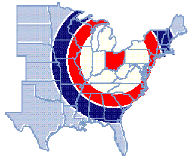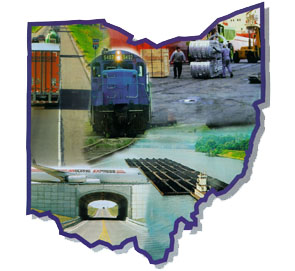

|

|


|

|
In the river city of Steubenville in eastern Ohio, archaeology students grub carefully in an excavated pit. They meticulously peel away layers of dirt, uncovering fragments of previous civilizations -- arrowheads and pottery shards from the Algonquin tribes, buttons from the coats of the engineers who mapped the Northwest Territory, bits of industrial detritus from more recent times.
|
The beautifully restored Fort Steuben is the genesis of Ohio (although the honor of the first permanent settlement in Ohio goes to the downstream city of Marietta). In the 1780s the young federal government sent a troop of engineers to survey the large unsettled wilderness east of the Alleghenies. The early engineers mapped ranges, townships and sections in a grid pattern that became the model for all subsequent states, except Texas. Plots were sold to settlers for as little as 50 cents to $1 an acre. The proceeds were used to run the nearly penniless government. |
The government carved five new states (Ohio, Indiana, Illinois, Michigan, Wisconsin and parts of Minnesota) from the Northwest Territory. Pioneers, eager for their piece of the American dream, piled their belongings onto river boats, rafts and wagons and began the westward thrust. Ohio was the staging point for that movement, and thus became known as America's First Frontier.
Ohio has always been a state on the move. Many of the pioneers traveled an early wagon trail, later designated the "National Road," and, later still, U.S. 40. The new "national road" is I-70, which parallels U.S. 40 through Ohio on its way across country to the west coast.
|
In the early days of statehood, Ohio was isolated from the burgeoning markets in the east, so it built a 1,000-mile long system of interlocking canals to connect the farms to Lake Erie and the Ohio River. By the time the digging stopped in the mid-1800s, Ohioans had already turned to a new form of transportation -- the railroad. The first line in the country was the Baltimore & Ohio (the progenitor of today's CSX).
By the mid-19th century, the canals and railroads had opened up Ohio's fields, forests and mines to the outside world, and there was no stopping the industrialization that began to take place. Manufacturing began to supersede agriculture in economic importance 150 years ago. |

|
Many of the early pioneers elected to stay in Ohio, establishing farms and small businesses. In this polycultural group were an inordinate number of inventors, whose minds sparked ideas for rubber, the roller bearing, the first gasoline-powered automobile, the cash register, the motion picture projector, the vacuum cleaner, the electric light -- not to mention the hot dog.
Ohio gave flight to the world and is a continuing pioneer in aviation achievements. The nation's first air express shipment winged its way from Dayton to Columbus and the first airmail flight from Cleveland to Chicago. An Ohioan was the first American to orbit the earth and the first man to set foot on the moon.
The point of the history lesson is to prove that Ohio was born as a transportation crossroads and continues in that role today -- whether the destination is one of the 172 global markets Ohio industry serves or a distant celestial body.
|
Logistics experts will say that Ohio is better situated to serve markets than any other state. Equidistant from Northeast and Midwest population concentrations, Ohio is in perfect position to reach the double industrial and consumer markets of Detroit-Chicago-St. Louis and Pittsburgh-Philadelphia-Toronto.
Sixty-one percent of the U.S. population, and 63 percent of the U.S. manufacturing facilities lie within 600 miles of Ohio. Over half of Canada's markets are in the same range. Ohio itself is a substantial consumer market of 11.1 million people housed in eight metro areas, a dozen or so micropolitan communities and hundreds of rural communities. To reach those markets, Ohio invested in a well-integrated transportation system. Ranking 35th in land area, Ohio has the 10th longest highway network and fourth largest amount of interstate mileage. The state has nearly 1,000 miles of navigable waterways. Lake Erie is Ohio's "north coast" and the marshaling point for regional and international shipments. The Ohio River -- navigable from Columbiana County in east Ohio to the Ohio/ Indiana/Kentucky border at Cincinnati -- is essential for low-cost barge transport, particularly for the chemical, metal and utility sectors. Over 180 public airports, including international hubs at Cleveland, Columbus and Cincinnati, put Ohio travelers within an hour of two-thirds of the U.S. population. State seed money supports continuing development of Ohio's logistics advantages. Rickenbacker, a former military base, is now a thriving distribution complex south of Columbus. A new air cargo superport is on the drawing boards at Youngstown-Warren. Readily seeing Ohio's distribution advantages, private companies are pumping capital into transportation projects. Airborne has its cargo hub/airpark at Wilmington in the southwest part of Ohio. Burlington Air Express selected Toledo for its cargo hub, and Emery Air Freight operates its superhub at Dayton International Airport. Five interstate highways section off the state. In the west, I-75 is the nation's most important carrier of auto parts and components. In the east, I-77 passes through the hills of Appalachian Ohio and the nation's plastics capital, Akron, before moving on to the Cleveland metro area and Lake Erie. I-70 bisects Ohio's belly, and I-80/90, the Ohio Turnpike, its head. Tying the interstate network together is the diagonal slice of I-71 from Cleveland to Cincinnati. In between the interstates is a good system of four-laned, limited access highways, such as Route 11, the river to Lake Erie highway in eastern Ohio, and State Route 32, the Appalachian Highway in the southern part of the state. Major transportation improvement projects throughout the state are easing the flow of goods and commuters. |
|
With more railroad track per square mile than any other state, Ohio is served by three Class I railroads -- Conrail, Norfolk Southern and CSX. A CSX spokesman says after the impending merger with Conrail, rail service will be even better.
|
The state has promised that no area will be isolated from rail service. The Rail Acquisition Program helps public entities and private investors acquire rail lines threatened by loss of service. The availability of shortline and regional railroads is critical to economic development in many parts of the state. More than a physical crossroads, Ohio is also a cultural one. Originally a melting pot of German, French, Italian and other peoples, Ohio today welcomes a large continent of Asian and European investors, who continue to bring their job-generating industrial facilities to the state. In fact, Ohio has ranked as the favorite location for foreign investors for the last three years in a row. |
Once the nation's leading agricultural state, and now the second greatest generator of manufactured products in America, Ohio's physical face has changed much in the past two centuries. But one early attribute -- the work ethic of its people -- remains undiminished. Perhaps the reason lies in the fact that Ohioans have managed to retain a good measure of the Puritan ethic the pioneers brought with them. Hard work and a sense of workplace responsibility are as apparent today as they were two centuries ago. That, in large part, is why Ohio for the last four years has attracted more new plants and expansions than any other state.